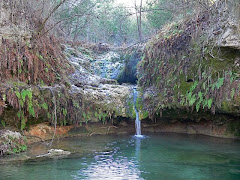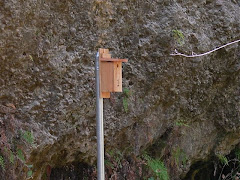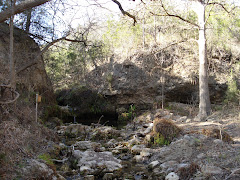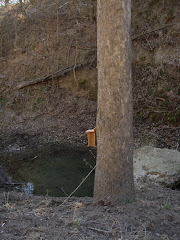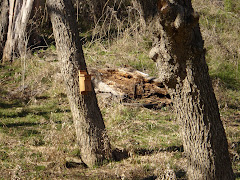
Sunday afternoon I decided to head out to the park as the day turned out too nice to skip. As I walked to the Hackenburg Creek site at 3:30 PM, I saw across the river and up stream a wildfire consuming the crown of a live oak tree.
Arriving at the nest box site I sat within view of both boxes 7 & 8 for about 10 minutes and saw no activity. I then sat by the river for about an hour hoping for some good bird sitings. I did see 5 Turkey Vultures swirl down to the far river's edge one at a time to hydrate themselves. Two vultures actually walked into the water up to their bellies to cool off on this warm 78 degree February day.
I watched a plane circle the fire for about 20 minutes before a large water tank helicopter showed up on the scene. This yellow machine spent the next two hours sucking water from the river and dumping buckets onto the fire. It was successfully put out by 5:30 PM.
During this time I returned to the grove of trees pursuing what birds were flitting around the bushes. Then I heard this harsh rattle down by the river. I recall Mikael telling me the Ringed Kingfisher's rattle is different then the Belted. So I quickly ran down to the river and observed a large kingfisher with a red belly fly upstream. I planted myself at the stream edge and waited as the helicopter was still hauling water to the fire and I could not imagine this bird would stay long upstream. Only two minutes later this bird flew right past me 30 feet away. It was a male Ringed Kingfisher, with a rusty red belly and white collar. In the U.S. this bird can only be found in Texas and its range goes all the way to southern South America.
Arriving at the nest box site I sat within view of both boxes 7 & 8 for about 10 minutes and saw no activity. I then sat by the river for about an hour hoping for some good bird sitings. I did see 5 Turkey Vultures swirl down to the far river's edge one at a time to hydrate themselves. Two vultures actually walked into the water up to their bellies to cool off on this warm 78 degree February day.
I watched a plane circle the fire for about 20 minutes before a large water tank helicopter showed up on the scene. This yellow machine spent the next two hours sucking water from the river and dumping buckets onto the fire. It was successfully put out by 5:30 PM.
During this time I returned to the grove of trees pursuing what birds were flitting around the bushes. Then I heard this harsh rattle down by the river. I recall Mikael telling me the Ringed Kingfisher's rattle is different then the Belted. So I quickly ran down to the river and observed a large kingfisher with a red belly fly upstream. I planted myself at the stream edge and waited as the helicopter was still hauling water to the fire and I could not imagine this bird would stay long upstream. Only two minutes later this bird flew right past me 30 feet away. It was a male Ringed Kingfisher, with a rusty red belly and white collar. In the U.S. this bird can only be found in Texas and its range goes all the way to southern South America.

